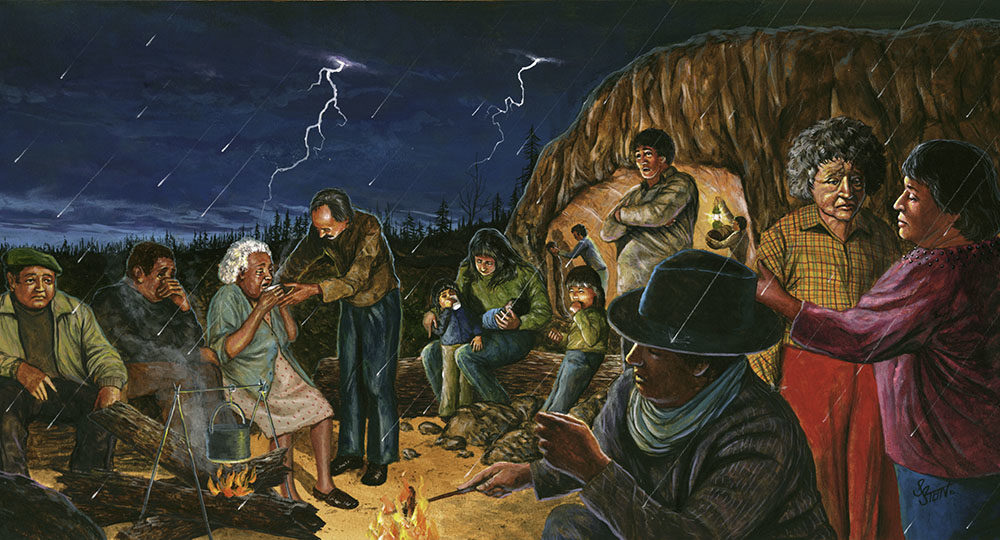The Judgment Phase of the Broad Day of the Lord
A Significant Question
A previous article demonstrated that the broad Day of the Lord will begin with a phase of divine judgment. What will be the duration of this judgment phase? What time span will it cover? In order to obtain an answer, several things must be examined.
Comparisons of the Day of the Lord, the Time of Jacob’s Trouble, and the Great Tribulation
The Scriptures indicate that the Day of the Lord, the time of Jacob’s trouble, and the Great Tribulation have several things in common. First, the concept of distress or tribulation is associated with “the day of the Lᴏʀᴅ” (Zeph. 1:14–17), “the time of Jacob’s trouble” (Jer. 30:7), and the Great Tribulation (Dan. 12:1) [Jesus’ Great Tribulation statements in Mt. 24:21 and 29 were a reference to Dan. 12:1). All of these Old Testament passages use the same Hebrew word for distress (translated “trouble” in the Jer. 30 and Dan. 12 passages). The Hebrew scholars who produced the Septuagint (the ancient Greek translation of the Hebrew Old Testament) used the Greek word for distress in the Zephaniah and Daniel passages, indicating their understanding that both the Day of the Lord and the Great Tribulation will be characterized by tribulation.
In light of the fact that the Day of the Lord will be characterized by tribulation and the outpouring of God’s wrath (Zeph. 1:14–15), it is evident that the Bible associates tribulation with the outpouring of God’s wrath. Similarly, Romans 2:5–9 and 2 Thessalonians 1:6–10 link tribulation with the future outpouring of God’s wrath on the unsaved.
Second, the unparalleled time of trouble is identified with “the day of the LORD” (Joel 2:1–2), “the time of Jacob’s trouble” (Jer. 30:7), and “the great tribulation” (Dan. 12:1 and Mt. 24:21). In light of this, and the fact that there can be only one unparalleled time of trouble, it can be concluded that the future Day of the Lord will include the same time period as the time of Jacob’s trouble and the Great Tribulation.
Third, Israel’s future repentance and return to God are associated with “the day of the Lᴏʀᴅ” (Zech. 14:1–3; 12:2–3, 9–14; 13:1–2), “the time of Jacob’s trouble” (Jer. 30:7–9, 22), and the latter-day “tribulation” (Dt. 4:27–30; 30:1–2).
These comparisons demonstrate that the broad Day of the Lord will at least cover or include the same time period as the time of Jacob’s trouble and the Great Tribulation. Therefore, in order to determine the duration of the judgment phase of the broad Day of the Lord, we must examine the duration of the Great Tribulation.
The Beginning of the Great Tribulation
The Great Tribulation will begin in the middle of the seven-year period known as the 70th Week of Daniel 9. The evidence for this is as follows: Daniel 9:27 teaches that in the middle of the 70th Week, the Antichrist will begin desolation in conjunction with “the overspreading of abominations.” Jesus referred to this activity of the Antichrist in Matthew 24:15 and then said, “then shall be great tribulation, such as was not since the beginning of the world to this time, no, nor ever shall be” (Mt. 24:21). Jesus thereby indicated that the Great Tribulation will begin in the middle of the 70th Week when the desolation of Daniel 9:27 begins.
The Length of the Great Tribulation
The Great Tribulation will last throughout the entire second half of the 70th Week of Daniel 9. In other words, it will cover the second three and one-half years of that seven-year period. Several things indicate this.
First, Jesus forewarned the Jews who will be living in Judea during the 70th Week to flee to the wilderness of the mountains when the Antichrist begins the abomination of desolation in the middle of that seven-year period. He told them to flee because the enactment of the abomination of desolation will begin the Great Tribulation (Mt. 24:15–21).
This forewarning indicates two things. First, the enactment of the abomination of desolation in the middle of the 70th Week will initiate a time of terrible persecution of the Jews. Second, the Great Tribulation will be characterized by severe persecution of the Jews and their hiding in a wilderness. Any indication of the length of this persecution and hiding will indicate the length of the Great Tribulation.
In Revelation 12, John was given a preview of the 70th-Week persecution of the 70th Week persecution of Israel by Satan (vv. 3, 9, 13). (The sign of the woman [vv. 1–2, 4–5) is based on Old Testament imagery portraying Israel (Isa. 54:5–6; Ezek. 16:7–14).) John indicated that Israel will flee to a wilderness in order to escape this persecution (vv. 6, 14), and Satan will try to destroy Israel (vv. 15–17).
Revelation 12 expresses the length of this persecution and the hiding of the Jews in two ways. First, it will last for 1,260 days (v. 6). The Bible employed the ancient lunar (moon) calendar system, which reckoned a year to consist of 360 days. The 1,260 days of Revelation 12:6, divided by 360 days, equals three and one-half years—exactly one-half of the seven-year 70th Week.
Second, Revelation 12:14 states that Israel will hide in the wilderness from Satan for “a time, and times, and half a time.” Daniel 7:25 uses this same time designation for the period during which the Antichrist will persecute the saints of the 70th Week. There the original language indicates that this designation refers to three and one-half times. How long will that three and one-half times be? Revelation 13:5–7, when referring to this same persecution of 70th-Week saints by the Antichrist, declares that it will last for 42 months, which equals three and one-half years. Thus, the three and one-half times of Daniel 7:25 and Revelation 12:14 equal three and one-half years.
It is evident, therefore, that the time expressions of Revelation 12:6 and 14 indicate the same thing: The Jews will be persecuted and will hide in a wilderness for three and one-half years—exactly one-half of the 70th Week. This prompts two conclusions. First, since the persecution and hiding will begin in the middle of the 70th Week the three and one-half years will cover the entire second half of the 70th Week. Second, since this persecution and hiding of the Jews will characterize the Great Tribulation, the Great Tribulation will last for the entire three and one-half years of the second half of the 70th Week.
The second indication that the Great Tribulation will cover the entire second half of the 70th Week is the fact that Daniel 12 also indicates this. In verse 1, Daniel was told about the unparalleled future “time of trouble,” which Jesus called the “great tribulation” in Matthew 24:21.
In Daniel 12:6, an angel asked how long this Great Tribulation would last. In verse 7, the angel was given two answers to his question. First, he was told that the Great Tribulation will last for “a time, times, and an half.” As noted earlier, this time designation equals three and one half years. Since the great Tribulation will begin in the middle of the 70th Week, this is another indication that it will last throughout the entire second half of the 70th Week.
Second, the angel was told that the Great Tribulation will be finished “when he shall have accomplished the breaking up of the power of the holy people.” A study of the original language used in the answer indicated the following meaning: The Great Tribulation will be finished when God has completed the shattering of the obstinate rebellion of Israel against Himself. In other words, the Great Tribulation will end when Israel’s rebellion against God ends. According to Daniel 9:24, Israel will not stop its rebellion against God until all 70 Weeks of His extended program for that nation have run their course (the word translated “transgression” in the expression “to finish the transgression” has the root meaning to rebel).1 In other words, Israel’s rebellion will end when the 70th Week ends. In light of this, since the angel was told that the Great Tribulation will end when Israel’s rebellion ends, the Great Tribulation will not end until the end of the 70th Week.
In Daniel 12:7, as the heavenly being gave these two answers to the angels question, he raised both hands toward heaven and swore an oath by God. Usually only one hand is raised in the swearing of an oath. The raising of both hands emphasized the solemnity and importance of the oath.2 This was the heavenly being’s way of asserting the truthfulness and reliability of his answers and therefore of affirming in the strongest possible way the absolute certainty that the Great Tribulation will last until the very end of the 70th Week.
The Shortening of the Great Tribulation Days
After discussing the Great Tribulation, Jesus said, “And except those days should be shortened, there should no flesh be saved; but for the elect’s sake those days shall be shortened” (Mt. 24:22). Did Jesus mean that God will shorten the Great Tribulation to less than three and one-half years or fewer than 1,260 days and that, therefore, the Great Tribulation will not last until the end of the 70th Week?
Mark’s record of Jesus’ statement sheds light on its meaning. “And except the Lord had shortened those days, no flesh should be saved; but for the elect’s sake, whom he hath chosen, he hath shortened the days” (Mk. 13:20). On the basis of the primary meaning and tense of the verbs translated “shortened,” scholars have concluded that Jesus was teaching the following: God has already shortened the Great Tribulation. In eternity past, God determined to cut off the Great Tribulation at 1,260 days, rather than let it run indefinitely, so that all flesh would not perish from the earth. Thus, Jesus’ statement does not nullify what was seen earlier. The Great Tribulation will last until the end of the 70th Week.
Conclusions
This article has given evidence that the judgment phase of the broad Day of the Lord will cover or include the Great Tribulation, and that the Great Tribulation will last until the end of the 70th Week. It can therefore be concluded that the judgment phase of the Day of the Lord will also extend to the end of the 70th Week.
An earlier article (“The Day of the Lord,” Dec. 1991/Jan. 1992) gave evidence that the future Day of the Lord will begin at the beginning of the 70th Week. All of this indicates that the judgment phase of the broad Day of the Lord will start at the beginning of the 70th Week and will extend to the end of that seven-year period.
ENDNOTE
- H. C. Leupold, Exposition of Daniel (Grand Rapids, MI: Baker Book House, 1949), 412.
- Leon Wood, A Commentary on Daniel (Grand Rapids, MI: Zondervan Publishing House, 1973), 323.









We also recognize that Israel is the subject of Revelation 12 as indicated by verses 1 and 2. It portrays the dream of Joseph as recorded in Genesis 37:1-11